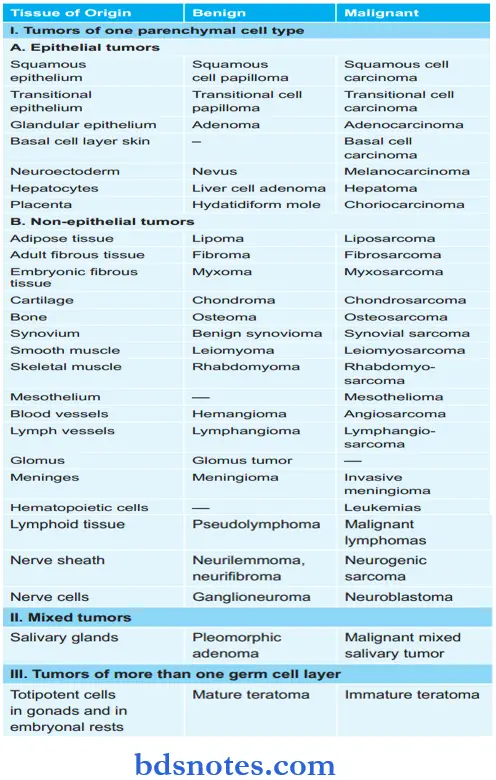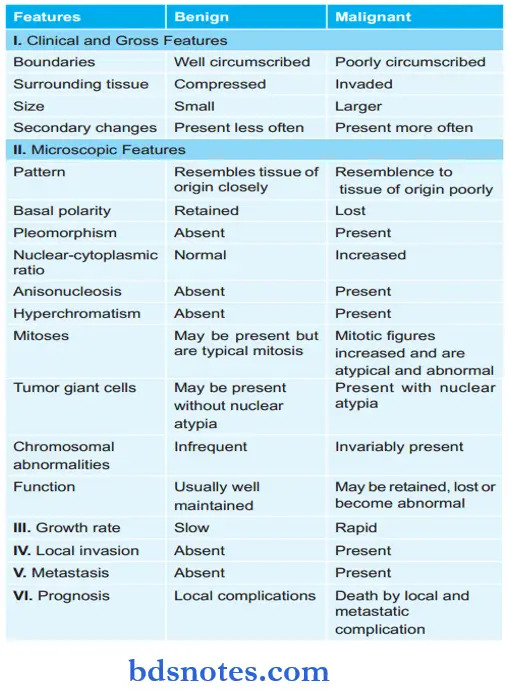Neoplasm
Question 1. How to define neoplasia and how do you classify them? Differentiate benign and malignant tumors of the head and neck.
Or
Define and classify neoplasia. Write down the differences between benign and malignant tumors.
Answer:
The term neoplasia means new growth, the new growth produced is called a neoplasm or tumor.
Neoplasm is a mass of tissue formed as a result of the abnormal, excessive, uncoordinated, autonomous, purposeless proliferation of cells even after cessation of stimulus for growth which caused it.
Classification of Tumors
- Benign tumors: They are generally spherical to ovoid in shape. They are encapsulated or well-circumscribed, freely movable, more often fim and uniform, unless secondary
changes like hemorrhage or infarction, supervene. - Malignant tumors: They are usually irregular in shape, poorly circumscribed, and extend into the adjacent tissues. Secondary changes like hemorrhage, infarction, and
ulceration are seen. Malignant tumors are also known as cancer. - Malignant tumors of epithelial origin are called carcinomas while malignant mesenchymal tumors are called sarcomas.
Read And Learn More: Pathology Question And Answers
Currently, the classification of tumors is based on histogenesis and anticipated behavior.

Question 2. Write the differences between benign and malignant neoplasm.
Or
Write the differences between benign and malignant neoplasm.
Or
Write the difference between benign and malignant tumors.
Or
Define neoplasia. Give its classification and differences between benign and malignant tumors.
Answer:

Question 3. Write a short note on malignant neoplasm.
Answer:
The characteristics of malignancy are as follows:
- Rate of growth.
- Clinical and gross features
- Microscopic features
- Local invasion or direct spread
- Metastasis or distant spread.
Malignant neoplasm Rate of Growth
In general malignant neoplasm grow rapidly. The malignant tumor cells have an increased mitotic rate and slower death rate, i.e. cancer cells do not follow normal control in the cell cycle and are immortal.
Secondly, the rate of growth of malignant tumors is directly proportional to the degree of differentiation. Malignant tumors grow in size because cell production exceeds cell loss.
Malignant Neoplasm Clinical and Gross Features
The malignant tumors are irregular in shape, poorly circumscribed, and extend into adjacent tissue. Secondary changes like hemorrhage, infarction, and ulceration are seen more often.
Malignant neoplasm Microscopic Features
- The malignant tumors have a poor resemblance to their origin.
- Basal polarity is lost.
- Pleomorphism is present.
- The nucleo-cytoplasmic ratio is increased.
- Anisonucleosis is generally present.
- Tumor giant cells are present with nuclear atypia.
Malignant neoplasm Local Invasion
Tumors invade via routes of least resistance eventually most cancers recognize no anatomic boundaries. The cancers extend through tissue space, permeate lymphatics, blood vessels, and perineural spaces, and may penetrate the bone by going through nutrient foramina.
Malignant neoplasm Metastasis or Distant Spread
- Lymphatic spread: In general carcinomas metastasize by lymphatic route. Virchow’s lymph node is nodal metastasis to the supraclavicular lymph node from cancers of the abdominal organ.
- Hematogenous spread: It is a common root for sarcomas but certain carcinomas are also spread by this mode. The common sites are the lung, breast, thyroid, kidney, liver, prostate, and ovary.
- Spread along body cavities and natural passages: the routes of distant spread are trans coelom, epithelial lined surfaces, CSF, and implantation.

Leave a Reply